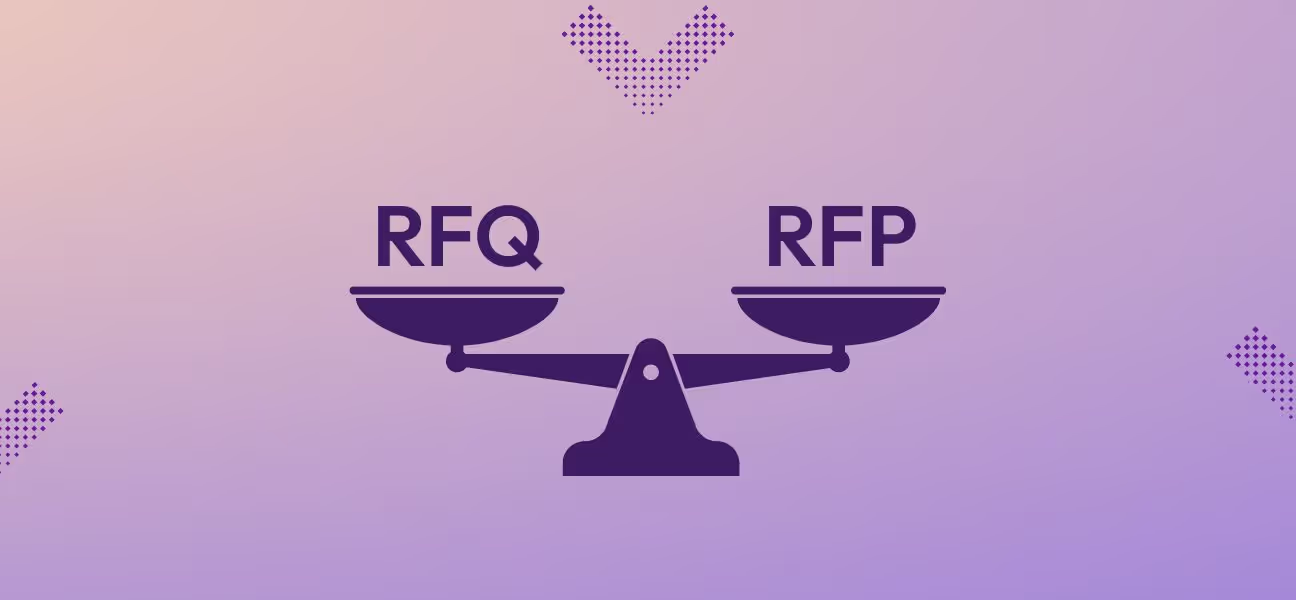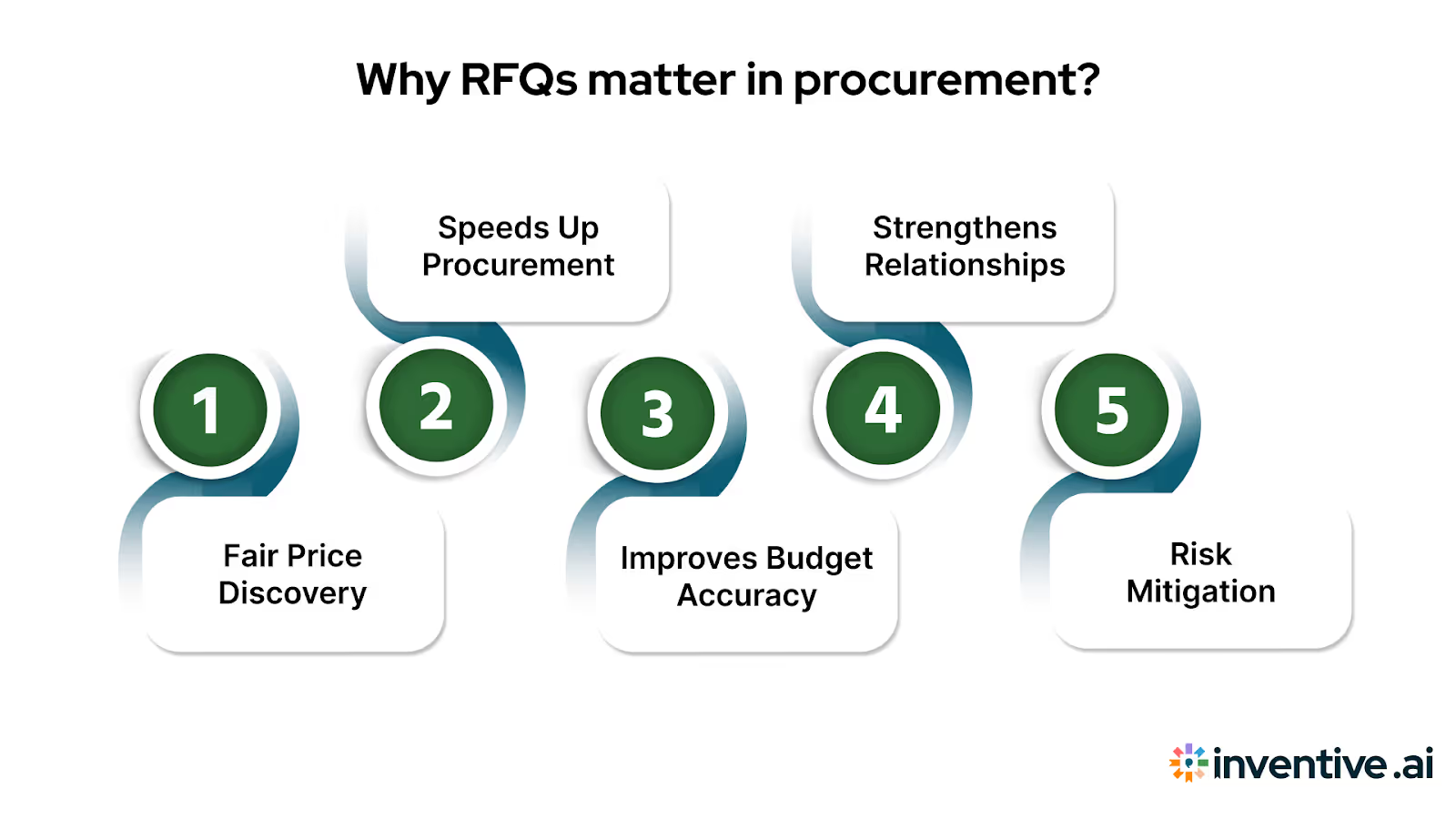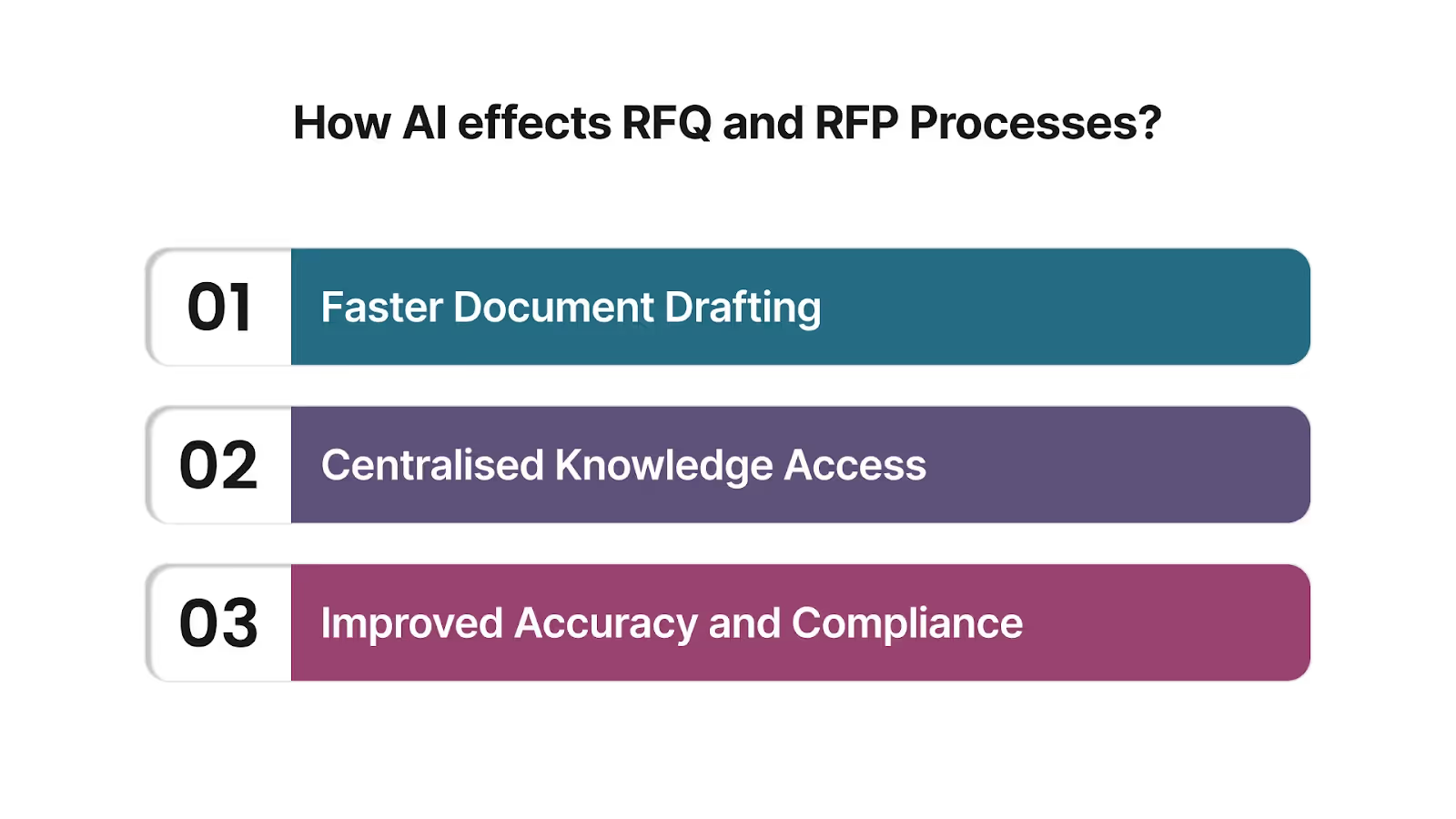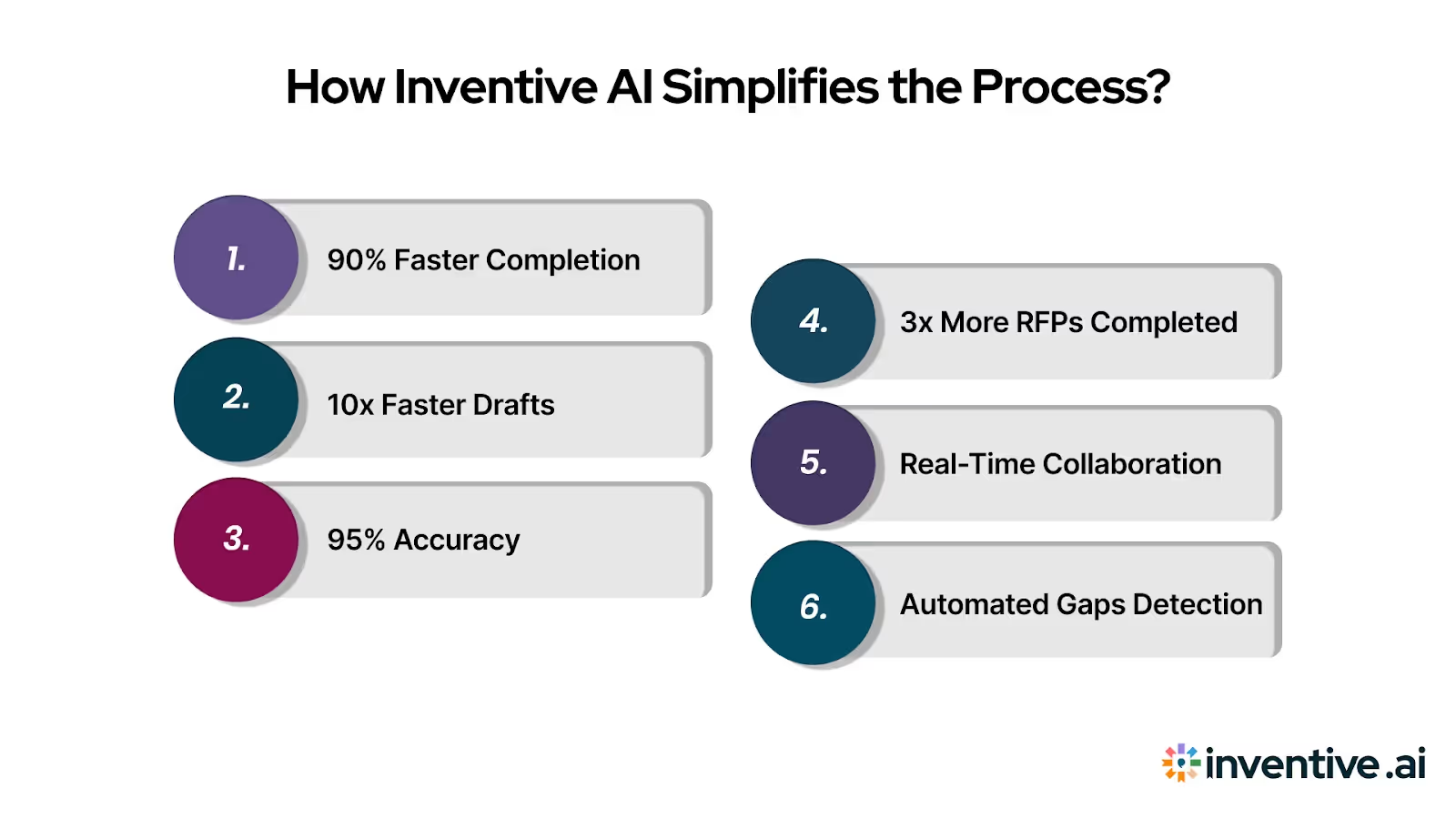RFQ and RFP: A Simple Comparison Guide for Better Procurement
Confused by RFQ vs. RFP? Learn the key differences with clear examples, see where they fit in the procurement process, and choose the right one every time.

Introduction
Procurement and sourcing teams face constant pressure to identify the right suppliers quickly while keeping costs under control. Yet many organizations struggle with a fundamental decision at the start of the process. Should they issue a Request for Quote (RFQ) or a Request for Proposal (RFP)? This uncertainty often results in delays, mismatched vendor responses, and increased costs.
The stakes continue to rise. Recent research shows that chief procurement officers (CPOs) now allocate up to 24% of their budgets to procurement technology, underscoring the importance of making efficient, well-informed choices.
In this guide, we clarify the purpose of RFQs and RFPs, highlight their key differences, and explain when each should be used. We’ll also explore how AI-native tools are transforming procurement by accelerating cycle times, improving decision quality, and delivering measurable savings.
Key Takeaways
- RFQs are best for simple, price-focused purchases, while RFPs are designed for complex, strategic buys that require detailed evaluation.
- RFQs speed up procurement for standardised goods and services by enabling quick price comparisons across vendors.
- Aligning RFQs with simple buys and RFPs with complex projects helps procurement teams avoid delays and costly misalignments.
- With 90% faster completion rates, verified content libraries, and collaboration tools, it helps vendors win more deals with less effort.
What is an RFQ?
A Request for Quote (RFQ) is a procurement document that focuses on collecting price estimates from vendors for clearly defined products or services. It is most effective when the requirements are straightforward, specifications are standardised, and cost is the primary decision-making factor.
For example, a company sourcing 1,000 units of office chairs with fixed dimensions and material requirements would issue an RFQ. Since all vendors are quoting for the exact product specifications, evaluation becomes easier and purely price-driven.
While RFQs are simple and price-driven, some situations demand a more detailed evaluation, which is where RFPs come in.
What is an RFP?
A Request for Proposal (RFP) is a formal document used to buy something when a company wants more than just a price quote. It wants vendors to offer detailed solutions, strategies, and expertise. Unlike RFQs, which are cost-focused, RFPs invite suppliers to explain how they will meet requirements, what differentiates their approach, and what value they can deliver beyond cost.
For instance, if a hospital is looking for a new electronic health record (EHR) system, it won’t just ask vendors for a price. It will issue an RFP to evaluate system capabilities, compliance with regulations, integration options, support services, and pricing.
Now that we’ve clarified what each document means, it’s essential to explore why both RFQs and RFPs matter in modern procurement.
Must Read: Top 25 RFP Software in 2025: Which to Use?
RFI, RFQ, and RFP: Understanding the Complete Procurement Toolkit
Procurement teams rely on three core documents, i.e., RFI, RFQ, and RFP, to guide supplier selection. Each serves a distinct role in the sourcing journey, but together they form a structured process for smarter, faster decisions.
- RFI (Request for Information): Used at the discovery stage to gather market intelligence and understand vendor capabilities. RFIs help teams narrow the field before moving forward.
- RFQ (Request for Quote): Issued when requirements are well-defined and pricing is the key factor. Vendors compete primarily on cost and delivery terms.
- RFP (Request for Proposal): Best for complex projects where organizations need to evaluate not just price but also technical expertise, compliance, and long-term value.
RFI, RFQ, and RFP are most effective when used as part of a sequence rather than in isolation. Organizations often begin with an RFI to gather high-level information about the market and identify which vendors are capable of meeting their needs.
Once requirements are clear, the process moves to an RFQ, where shortlisted vendors are invited to provide detailed pricing and delivery terms for standardized products or services.
Finally, when the project is more complex and requires a deeper evaluation of technical capabilities, compliance, and long-term fit, the organization issues an RFP. By following this progression, i.e., RFI for discovery, RFQ for cost comparison, and RFP for comprehensive evaluation, procurement teams ensure they have the correct information at each stage, leading to more informed decisions, stronger supplier relationships, and reduced sourcing risk.
Importance of RFQ

A Request for Quote (RFQ) is one of the most widely used tools in procurement because it simplifies buying when requirements are clear and standardised. Its primary importance lies in helping organisations achieve cost competitiveness, efficiency, and consistency across suppliers.
Here’s why RFQs matter in procurement:
- Enables Fair Price Discovery: By asking multiple vendors to submit quotes for identical specifications, buyers can benchmark costs and avoid overpaying.
- Speeds Up Procurement Cycles: Since RFQs are short and straightforward, they reduce administrative workload and allow teams to move from request to purchase quickly.
- Improves Budget Accuracy: Procurement teams can use vendor quotes to forecast costs more precisely and negotiate volume discounts.
- Strengthens Supplier Relationships: RFQs create a transparent process where vendors compete on equal footing, encouraging trust and long-term partnerships.
- Risk Mitigation: By comparing quotes, buyers reduce the risk of relying on a single supplier or hidden pricing discrepancies.
Just as RFQs bring speed and cost clarity, RFPs add strategic depth and ensure the right long-term fit with vendors.
Importance of RFP
A Request for Proposal (RFP) is important when a company needs more than just a price quote. They need a strategic solution, the expertise of the vendor, and long-term value. Unlike RFQs, which are transactional, RFPs enable buyers to evaluate vendors holistically, considering factors such as innovation, compliance, and service quality.
Here’s why RFPs are important in procurement:
- Comprehensive Evaluation: RFPs assess both cost and methodology, technical capabilities, and vendor experience.
- Strategic Alignment: They ensure that vendors’ solutions align with the organisation’s goals, whether it’s digital transformation, sustainability, or risk management.
- Encourages Innovation: By allowing vendors to propose unique approaches, RFPs open the door to creative solutions that may outperform standard offerings.
- Risk Management: Detailed responses highlight vendor strengths and weaknesses, helping buyers avoid costly misalignments or project delays.
- Supports Complex Projects: RFPs are indispensable for high-value or specialised purchases, such as IT platforms, logistics partnerships, or healthcare systems.
With both sides explained, the next step is to directly compare RFQs and RFPs so procurement teams can see the differences at a glance.
RFQ and RFP: Key Differences
While both RFQs and RFPs are procurement tools, they serve very different purposes.
The table below highlights the main differences:
Understanding these differences is useful, but knowing when to use each method is what makes procurement efficient and effective.
When to Use RFQ vs RFP in Procurement?
Choosing between an RFQ and an RFP depends on the clarity of your requirements and the strategic importance of the purchase. Using the right method speeds up procurement and ensures you get the best value from suppliers.

Alt text: Using RFQ vs RFP in Procurement
Here’s when to use an RFQ -
- Standardised Products or Services: RFQs are ideal when requirements are clearly defined, such as raw materials, office supplies, or simple maintenance services.
- Price-Driven Decisions: If the main factor is cost and all vendors can deliver the same output, an RFQ ensures transparent price comparison.
- Low Complexity Purchases: When the risk of failure is minimal, and no customisation is needed.
- Quick Turnaround: RFQs save time because they make evaluation easy because quotes can be directly compared.
Here’s when to use an RFP -
- Complex or Strategic Purchases: RFPs are suited for projects requiring tailored solutions, such as ERP systems, logistics networks, or healthcare technology.
- Multiple Criteria: Use an RFP when evaluation criteria extend beyond price to include vendor experience, innovation, or compliance. For example, look at innovation, vendor experience, or compliance.
- Higher Risk Projects: RFPs allow buyers to assess vendor reliability and long-term support, reducing project risk.
- Long-Term Partnerships: When the goal is not just a purchase but a relationship, such as outsourcing IT services or selecting a consulting partner.
Struggling with slow RFQ and RFP responses? Manual workflows, scattered documents, and tight deadlines don’t have to hold your team back. Book a Call Now with our team to see how Inventive AI can simplify your RFQ and RFP process and give your business a competitive edge.
Even with clear guidelines, teams often find execution challenging. That’s why practical tips can make managing RFQs and RFPs much easier.
Must Read: Free Guide to Logistics RFP Management
Practical Tips for Teams Handling RFQ and RFP
Handling RFQs and RFPs can feel overwhelming if the process isn’t structured. A few simple practices can make the job easier, save time, and lead to better supplier choices.
1. Use Ready-Made Templates
Instead of starting from scratch every time, keep standard RFQ and RFP templates ready. These should include common sections like pricing, timelines, and evaluation criteria.
Example: A retail chain uses one RFQ template for all regional offices, so every team follows the same process and nothing gets missed.
2. Be Clear About What You Need
When you send out an RFQ, make sure that the details are clear about things like size, quantity, or material. For an RFP, explain your business goals clearly and tell vendors how you’ll judge their proposals.
Example: A hospital issuing an RFP for IT software might say: “40% cost, 30% security features, 30% support services.” This helps vendors focus their answers.
3. Involve the Right People Early
Don’t wait until the last moment to involve other departments. Finance, IT, or end-users should review the requirements before sending them out. This avoids rework later.
Example: A construction company sent out an RFQ for equipment without first talking to the operations team. When they got the quotes back, they saw that half of them didn't meet the needs of the site.
4. Use Simple Scoring to Compare Vendors
Make comparisons easier with a scoring sheet. For RFQs, you can line up costs side by side. For RFPs, assign points for things like experience, approach, and price.
Example: A healthcare provider scores each RFP on a 100-point scale, covering cost, compliance, and vendor track record. This way, decisions are fair and transparent.
5. Use Technology to Save Time
AI tools can draft responses, store old documents, and even highlight outdated information so teams don’t repeat work. Platforms like Inventive AI act as a single hub for all past RFQs and RFPs, making it much faster to prepare new ones.
6. Learn from Each Project
After every RFQ or RFP, note what worked and what caused delays. Over time, this creates a playbook your team can reuse.
Example: A logistics company keeps track of vendors who consistently deliver late. This record helps them avoid repeating mistakes in future contracts.
Common Pitfalls to Avoid
Even experienced procurement teams can run into challenges when managing RFIs, RFQs, and RFPs.
Avoiding these common mistakes can save time, reduce costs, and improve vendor alignment:
- Using the wrong document: Issuing an RFQ when requirements aren’t finalized, or an RFP when only pricing is needed, leads to wasted effort and mismatched vendor responses.
- Unclear or incomplete requirements: Vague specifications result in inconsistent proposals and make it harder to compare vendors fairly.
- Overemphasis on cost alone: Choosing the lowest price without weighing quality, compliance, or innovation often increases long-term risk and total cost of ownership.
- Lack of stakeholder input: Excluding IT, finance, or end users from the process can create gaps in requirements and reduce adoption later.
- Failure to consider scalability and future needs: Focusing only on today’s requirements without assessing how solutions will grow with the business can lead to costly re-sourcing later.
While good practices improve efficiency, AI adds another level of speed, accuracy, and collaboration to the process.
How AI Improves RFQ and RFP Processes?

Alt text: AI Improving RFQ and RFP Processes
RFQs and RFPs can take a lot of time for procurement teams to handle. They have to write documents, find information, and go over vendor responses. AI changes this by automating repetitive work, improving accuracy, and helping teams make faster, smarter decisions.
1. Faster Document Drafting
AI can generate the first draft of an RFQ or RFP by pulling from past documents, templates, and approved company content. Instead of starting from scratch, teams get a head start and only need to fine-tune details.
2. Centralised Knowledge Access
Spreadsheets with prices, emails with technical details, and shared drives with old responses are all places where information can get lost. AI platforms act as a central hub, making it easy to find and reuse relevant content. This prevents duplication and ensures consistency across all responses.
3. Improved Accuracy and Compliance
AI tools can flag outdated or conflicting information before an RFQ or RFP is finalised. This reduces the risk of sending incorrect data to buyers, which can otherwise hurt credibility. In regulated industries like healthcare or finance, this also ensures proposals meet compliance requirements.
4. Smarter Vendor Evaluation
AI helps people look over responses that come in. By using scoring models, AI can quickly rank vendor proposals based on factors such as cost, delivery timelines, or technical fit. This allows procurement teams to focus on the best candidates rather than manually reviewing every detail.
5. Reduced Response Times
By automating repetitive steps, AI enables teams to handle more RFQs and RFPs without adding staff. Research shows that organisations using AI in proposal management can reduce response times by up to 90%, freeing teams to focus on strategy and negotiation instead of admin work.
6. Collaboration Across Teams
Buying things often involves input from many departments, such as legal, operations, finance, and IT. AI platforms integrate with tools like Slack or Microsoft Teams, making it easier for everyone to collaborate in real time and stay on the same page.
Beyond general AI benefits, let’s see how Inventive AI specifically transforms the way organisations respond to RFQs and RFPs.
Must Read: How to Create an Effective RFP Response
Beyond Cost: Evaluating ESG, Security and Innovation in Modern RFPs
While cost remains an important factor in procurement, modern RFPs increasingly emphasize environmental, social, and governance (ESG) performance, data security, and innovation. Buyers want partners who not only deliver value today but also reduce long-term risks and align with broader organizational goals.
- ESG Commitments: Vendors are now evaluated on their sustainability practices, labor policies, and diversity initiatives. Organizations want assurance that their suppliers support responsible sourcing and contribute to corporate ESG targets.
- Security and Compliance: With rising cyber risks and regulatory requirements, RFPs scrutinize how vendors protect sensitive data, maintain compliance with standards like HIPAA or GDPR, and ensure business continuity.
- Innovation and Future Readiness: Beyond meeting current needs, buyers look for partners who bring forward-looking solutions, invest in AI and automation, and demonstrate a roadmap that evolves with market demands.
By going beyond cost and embedding ESG, security, and innovation criteria into RFP evaluations, organizations can select suppliers who deliver resilience, trust, and long-term strategic value.
How Can Inventive AI Help With RFQ and RFP Process?

Alt text: Inventive AI Helping With RFQ and RFP Process
Responding to RFQs and RFPs is critical for winning new business. Yet for most sales, proposal, and procurement teams, the process is slow, manual, and filled with repetitive tasks. It can take days or even weeks to write responses, find documents that are all over the place, and work with people from different departments. The result? Missed deadlines, inconsistent responses, and lost opportunities.
Inventive AI’s AI-native RFP Response Software is designed to transform how vendors handle RFQs and RFPs. It automates drafting, centralises knowledge, and streamlines collaboration, so your team can focus on strategy, not paperwork.
90% Faster RFQ and RFP Response Completion
What once took entire teams 20–30 hours of manual effort can now be done in a fraction of the time. With Inventive AI, complete first-pass drafts for RFQs and RFPs are generated in under 3 hours, giving your team more time to refine messaging and strengthen proposals.
10x Faster Drafts From a Verified Content Library
Instead of digging through emails, folders, and spreadsheets, Inventive AI pulls pre-approved, up-to-date content from your company’s knowledge base, past responses, and product libraries. Teams can respond with confidence, knowing that all content is consistent, accurate, and aligned with current offerings.
95% Accuracy Using Confidence-Scored Responses
Each draft made by AI is linked to your official files, like pricing sheets, product details, policies, or case studies. Responses are scored by confidence level, so reviewers know exactly where human input is needed. This reduces rework, improves accuracy, and builds buyer trust.
3x More RFQs and RFPs Completed With the Same Team
Proposal and sales teams using Inventive AI report handling up to three times more requests without adding headcount. With auto-tagging, content reuse, and streamlined workflows, your team can respond to more opportunities while avoiding burnout.
Real-Time Collaboration Across Teams
Integrated with Slack and Microsoft Teams, Inventive AI makes it easy to bring finance, legal, solutions, and sales together in one place. You can assign sections, keep track of approvals, and get feedback all at once, without having to deal with endless email chains or messy version control.
Automated Detection of Content Gaps and Inconsistencies
Inventive AI automatically flags incomplete, outdated, or conflicting content before submission. Whether it’s a pricing mismatch, an expired SLA, or a misaligned technical claim, the platform catches issues early, ensuring polished and accurate responses every time.
Here’s why it matters for proposal, sales, and revenue teams:
- Cut response times by up to 90%.
- Eliminate manual copy-paste, version errors, and outdated content risks.
- Collaborate seamlessly across departments.
- Improve proposal accuracy with confidence-scored drafts.
- Respond to more RFQs and RFPs without overloading your team.
Overloaded with RFQs and RFPs? Inventive AI simplifies the process with automation, content reuse, and intelligent workflows. Request a Demo Today and see how Inventive AI can transform your procurement response workflow.
Conclusion
RFQs and RFPs are important tools for procurement, but managing them the old-fashioned way, by hand, slows down responses and makes it more likely that valuable opportunities will be missed. To stay competitive, vendors need a smarter, faster way to respond with accuracy, consistency, and confidence.
Inventive AI makes this possible. By automating drafting, centralising knowledge, and detecting content gaps before submission, it enables teams to cut response times by up to 90%, improve proposal quality, and win more deals without increasing headcount.
If your current RFQ and RFP process is draining resources and holding back your sales cycle, it’s time to change the way you work.
Ready to transform your RFQ and RFP workflow and close deals faster? Download the Case Study Now to see how Inventive AI helps vendors respond quicker, with higher accuracy, and win enterprise trust at scale.
FAQs
1. What is the main difference between an RFQ and an RFP?
An RFQ focuses on getting price quotes for clearly defined products or services, while an RFP asks vendors to propose detailed solutions, strategies, and costs for more complex needs.
2. When should I use an RFQ instead of an RFP?
Use an RFQ when the needs are standard and price is the most important thing, like when you need to buy office supplies, raw materials, or regular services.
3. Why are RFPs important in procurement?
RFPs are essential for complex or strategic projects. They allow buyers to evaluate price and vendor expertise, technical approach, innovation, and compliance with requirements.
4. How do RFQs and RFPs impact procurement efficiency?
Choosing the right approach speeds up procurement cycles, reduces costs, and ensures better supplier alignment. Using an RFQ for simple purchases avoids overcomplication, while an RFP for strategic buys reduces risks of poor vendor fit.


